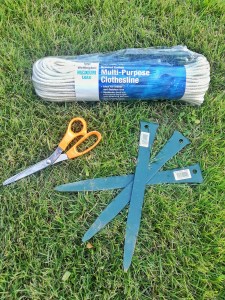Nothing dresses up a yard at Halloween time more than a floating ghost. Stores carry these guys plus floating zombies, monsters, and clowns, but they can get pretty pricey for some reason. Luckily for you, these are crazy easy to make. Please follow along, class.

First, as with all projects, you need to gather your materials.

For your floating ghost, you will need the following:
- A plastic skull
- Creepy cloth
- String
- A wire hanger
- Foam pipe cover
- Pliers
- Box cutter (not pictured)
- Outdoor duct tape (not pictured)
You can buy a skull and creepy cloth from Dollar Tree, so this project is not only easy; it’s insanely cheap. The foam pipe cover is pretty inexpensive, too. You can get a package at any hardware store for a couple of bucks. They actually sell white foam cover, too, but for this project I went with the dark gray.
After you’ve gathered your items, it’s time to start the assembly.
First, you need to make holes in the top and bottom of your skull. Cut a small hole in the top and one that’s a little larger in the bottom. You won’t be able to see them when you’re finished, so don’t worry about being exactly even.


Next up, it’s time to make the shoulders (yes, your ghost will have shoulders) and attach it to the head. My wire hanger was one with the cardboard middles, so I’d recommend using the same kind. If you only have a full wire hanger, you’ll need to untwist the hanger and shape it so you have a hook in the middle or just use a wire cutter to cut the middle of the bottom hanger bar.
Straighten out the sides of your hanger to make the shoulders of your ghost.
Add the foam pipe to the shoulders on each side and secure in the middle with duct tape. Use outdoor duct tape for the best results. That stuff works miracles.

Tie your string together to make a circle, and thread it through the bottom of your head up through the top hole or vice versa. Take the hook of the hanger and thread it through the string from the bottom hole.

After you hook the string, pull it through to secure your ghost. Add a few small pieces of duct tape to the top hole to keep the string from dropping through. When you’re finished, it will look like this:

Your last step is adding the creepy cloth. Just drape it over the ghost’s shoulders and head, threading the string through a hole in the cloth to secure it. You can add as much or as little as you want depending on how transparent you want your ghost to be.
Tada!!! Your ghost is finished!

Doesn’t he look cool? It was so easy that I plan on making a few more.

So there you go. You just made a cool decoration for your yard. And the beauty of this little project is that you can change it up quite easily. You can do all sorts of variations to make different kinds of ghosts or other types of monsters.
- Paint the head with glow paint.
- Use white foam cover and cheesecloth to create a classic ghost.
- Use a foam head with a mask.
- Add lights along the shoulders or draped down under the cloth.
- Add hands with extra wire and duct tape.
- Use longer, stronger wire to make a gigantic creature.
There are so many possibilities. Not to go self-help on you, but the only thing limiting yourself is you.
I hope you enjoyed this quick and easy tutorial. If you have any questions, feel free to leave a comment or shoot me a message through the contact page. Happy Haunting!


















































